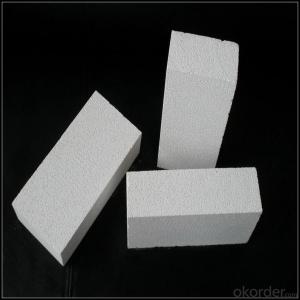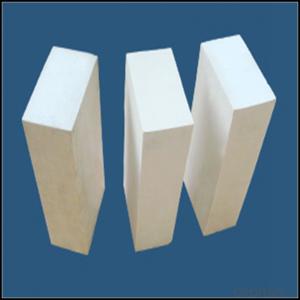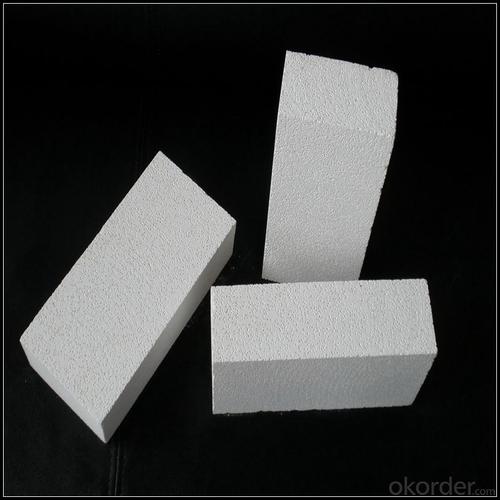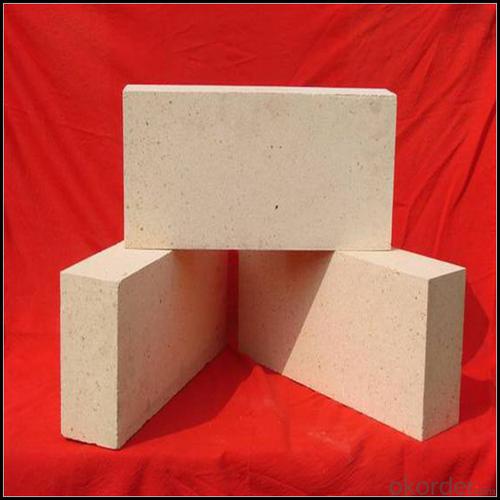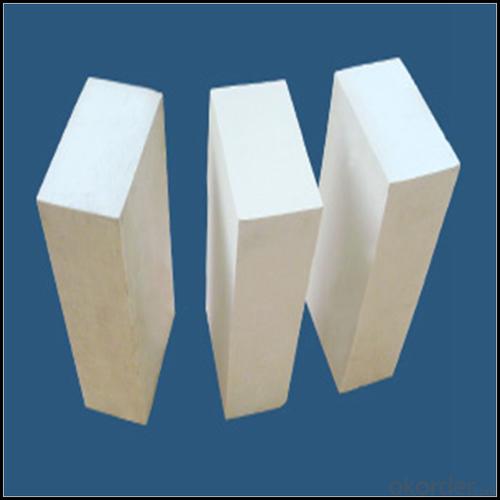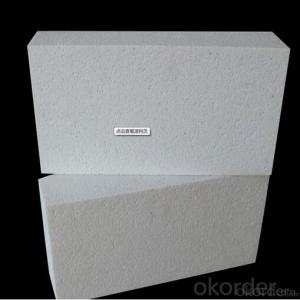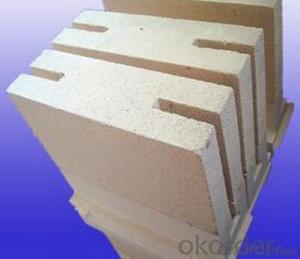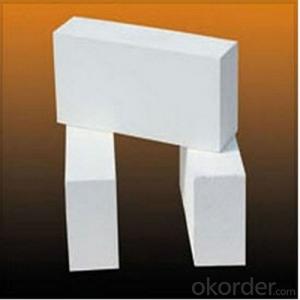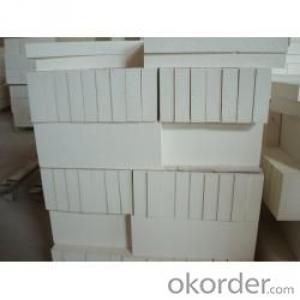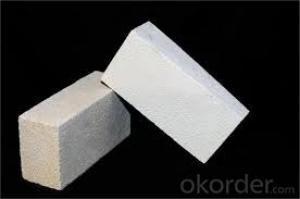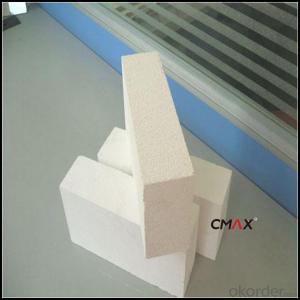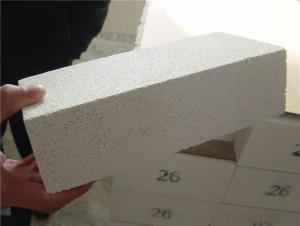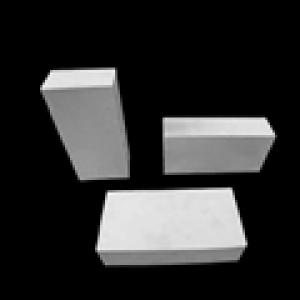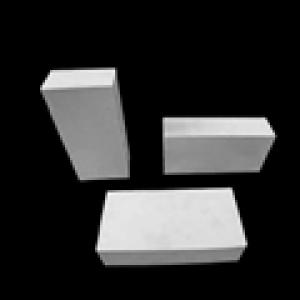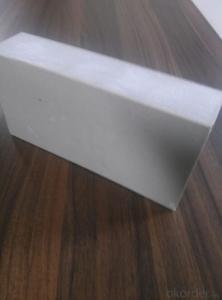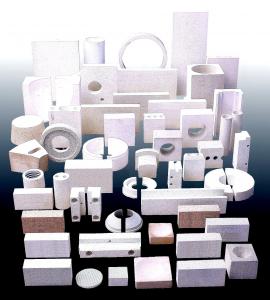Insulating Fire Brick - Acid Resistant Standard Size Bricks
- Loading Port:
- China main port
- Payment Terms:
- TT OR LC
- Min Order Qty:
- 0.1
- Supply Capability:
- 1800 m.t/month
OKorder Service Pledge
OKorder Financial Service
You Might Also Like
Refractory Brick
CMAX firebricks are classified under temperature between 1300℃ to 1700℃, manufactured from high purity alumina clay by mixing, press-forming, drying, sintering and machining. Bricks contain carefully-graded organic fillers which are burned out during sintering to give a uniform controllable pore structure. This technique makes product feature low thermal conductivity and excellent heat insulation
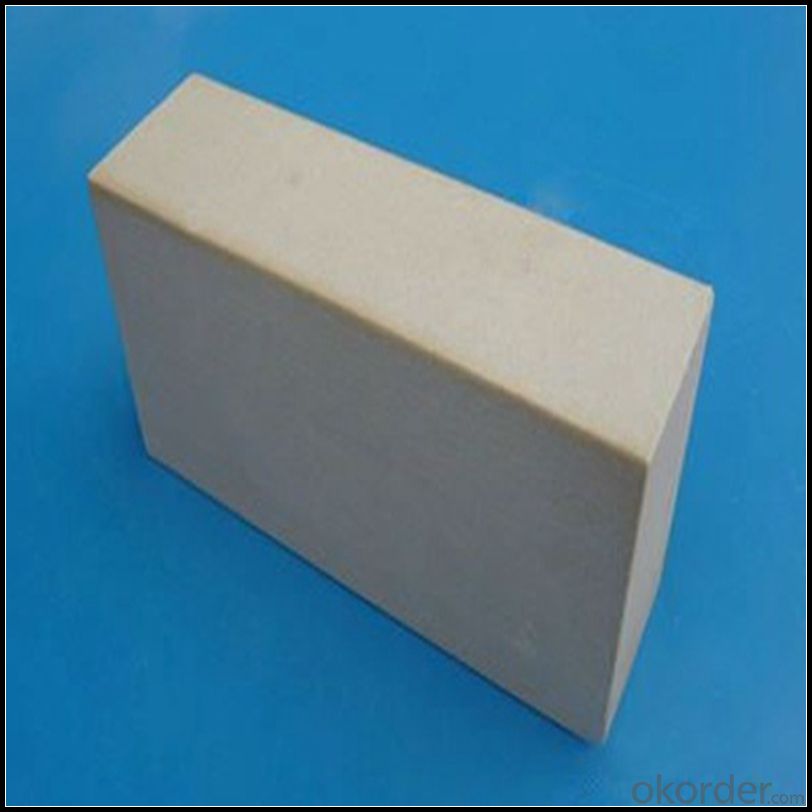
Features
a) Low thermal conductivity;
b) High refractoriness;
c) High mechanical strength;
d) Excellent thermal shock resistance;
e) Non standard sizes and shapes are available upon request.
Application
Light Weight Mullite Insulation Brick can be widely used for lining or insulation layers of various industrial furnaces and kilns in metallurgical industry, machine building industry, ceramic industry, chemical industry.
Data Sheet
Classification Temperature (℉/℃) | 3000/1650 |
Bulk Density (g/cm3 ) | ≤1.0 |
Thermal Conductivity | |
800℃, W/m.K | ≤0.39 |
1000℃, W/m.K | ≤0.43 |
1200℃, W/m.K | ≤0.48 |
Reheating Linear Change (%) | 1550℃×12h |
≤0.9 | |
Chemical Composition (%) | |
Al2O3 | ≥75 |
Fe2O3 | ≤0.5 |
Packaging & Shipping
Packaging Details:Be packed in fumigated wooden pallets
Delivery Detail: 30 days after order

Our Services
Optimum solution and product supply of refractories for high temperature industries, such as iron steel, non-ferrous, petrochemical and building materials.
Engineering design, contract and consult for refractories, and civil architecture design.
Research, development, manufacture and sale of superhard materials.
R&D, manufacture and sale of special packing materials for export.
Inspection, supervision and arbitration of refractories.
Consultation and services in refractories information.
Training and cultivation of high-level talents in refractories profession
Sales Network

Company Information
CNBM (China National Building Material) Group is the largest comprehensive building materials group in China that in integrate scientific research, manufacturing and logistics into one entity. The largest building materials and equipment specialists in China. Upon State Council approval, today CNBM owned more than 300 subordinate manufacturing factories and servicing companies. There are 6 fully owned public listed companies and 11 partially owned with substantial shares public listed companies. In many of these fields, CNBM is playing the leading role in the building industry in the country.
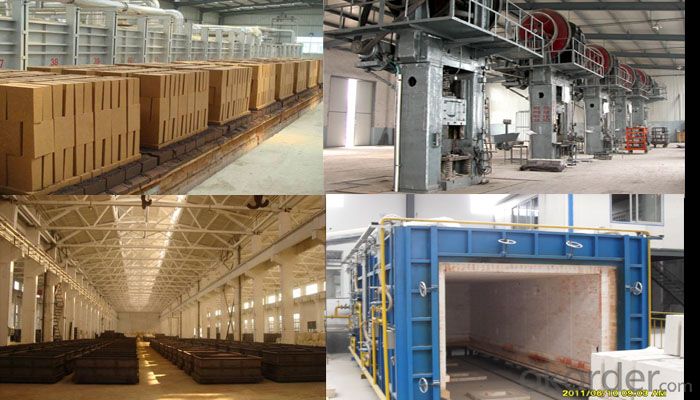
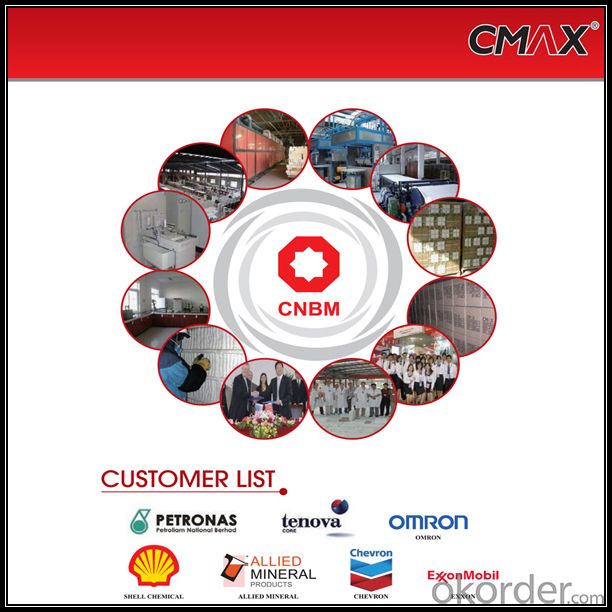
FAQ
1. Which products do you have?
We have all kinds of refractory brick, castable, mortar, cement, ceramic fiber products, etc.
Or you could browse our products to choose what you need.
2. Can you give me a brief introduction of the application of your products?
We are mainly specializing in the refractory materials in iron and steel, cement, glass, ceramics, petrochemical, electric power Industry, etc.
3. If I need your offer, what information do you need?
In order to choose suitable products, it will be appreciated to provide us the information, such us specification, technical data, order quantity, products application etc. If any question, please contact us freely.
- Q: Can insulating fire bricks be used in the construction of ovens or kilns for pottery?
- Yes, insulating fire bricks can be used in the construction of ovens or kilns for pottery. These bricks are designed to withstand high temperatures and provide excellent insulation, making them suitable for creating a stable and efficient heat environment required for pottery firing.
- Q: Can insulating fire bricks be used as a heat shield?
- Yes, insulating fire bricks can be used as a heat shield. They have excellent thermal insulation properties and can withstand high temperatures, making them an ideal choice for protecting against heat radiation and transferring minimal heat to the surrounding areas.
- Q: Can insulating fire bricks be used in the construction of pizza ovens?
- Indeed, it is possible to utilize insulating fire bricks during the construction of pizza ovens. With their ability to endure extreme temperatures and offer exceptional insulation, these bricks become an excellent choice for pizza ovens. They aid in the efficient preservation of heat, thus leading to a more uniform and steady cooking temperature. Additionally, due to their low thermal conductivity, insulating fire bricks effectively prevent heat dissipation, ensuring that the pizza oven remains hot for extended durations, thereby enhancing energy efficiency. All in all, incorporating insulating fire bricks into the pizza oven construction process can result in enhanced heat retention, improved cooking performance, and a more energy-efficient operation.
- Q: How do insulating fire bricks perform in terms of sound insulation?
- Insulating fire bricks are primarily designed for excellent thermal insulation, but their performance in terms of sound insulation can vary. While they can provide some sound reduction due to their dense and non-porous nature, they are not specifically engineered for soundproofing. The level of sound insulation offered by insulating fire bricks depends on factors such as brick thickness, density, and sound frequency. Generally, insulating fire bricks can somewhat reduce high-frequency noises, but they may not be as effective in blocking low-frequency sounds. For superior sound insulation, specialized acoustic materials or construction techniques may be more appropriate.
- Q: Are insulating fire bricks resistant to ammonia gas?
- Insulating fire bricks, in general, lack resistance against ammonia gas. Although these bricks are engineered to endure elevated temperatures and offer thermal insulation, they are commonly constructed from lightweight refractory materials, like clay or silica, which are not particularly resilient to corrosive substances such as ammonia gas. Over time, ammonia gas can react with these materials and result in deterioration or harm to the bricks. Consequently, if you require fire bricks for an environment containing ammonia gas, it is advisable to opt for specially designed acid-resistant or chemical-resistant bricks that can endure the corrosive impact of ammonia gas.
- Q: What is the recommended thickness of insulating fire bricks for optimal insulation?
- The thickness of insulating fire bricks recommended for optimal insulation can vary depending on the specific application and desired level of thermal protection. In general, it is commonly recommended to use insulating fire bricks with a thickness ranging from 2.5 to 4 inches (6.35 to 10.16 cm) for efficient insulation. Insulating fire bricks are designed to have low thermal conductivity, which effectively minimizes heat transfer. The insulation properties increase with thicker bricks, as they provide a greater barrier against thermal energy loss or gain. This is especially important in applications where maintaining a stable temperature is crucial, such as in industrial furnaces, kilns, or high-temperature appliances. To ensure optimal insulation performance, it is important to consider the specific requirements of the insulation project and consult with experts or manufacturers. Factors such as the maximum temperature, duration of exposure, and desired energy efficiency should be taken into account when determining the most suitable thickness for the insulating fire bricks.
- Q: Do insulating fire bricks require a specific curing or drying process before use?
- Yes, insulating fire bricks typically require a specific curing or drying process before use. This is done to remove any moisture or volatile organic compounds (VOCs) that may be present in the bricks, as well as to ensure they achieve their maximum insulating properties. The curing or drying process for insulating fire bricks usually involves slowly heating the bricks to gradually increase their temperature. This allows any moisture or VOCs to be released without causing any cracks or damage to the bricks. The rate of temperature increase and the overall duration of the curing process can vary depending on the type and thickness of the bricks. It is important to follow the manufacturer's instructions and recommendations for the specific type of insulating fire bricks being used. This will ensure that the curing or drying process is carried out correctly and that the bricks are ready for use in high-temperature applications such as kilns, furnaces, or fireplaces. Neglecting to properly cure or dry the bricks may result in reduced insulating properties and potential cracking or failure of the bricks when exposed to high temperatures.
- Q: Can insulating fire bricks be used in the construction of blast furnaces?
- Insulating fire bricks can indeed be utilized in the construction of blast furnaces. To maintain high temperatures, blast furnaces necessitate insulation, and insulating fire bricks offer exceptional thermal insulation properties. These bricks are crafted from lightweight materials like clay and alumina, which possess the ability to endure high temperatures without melting or deteriorating. With their low thermal conductivity, they effectively minimize heat loss and conserve energy within the blast furnace. Moreover, insulating fire bricks exhibit strong resistance to chemical reactions, rendering them suitable for the harsh conditions found in blast furnace environments. All in all, the insulation capabilities and heat-resistance of insulating fire bricks make them the preferred choice for constructing blast furnaces.
- Q: Can insulating fire bricks be used in the construction of refractory coatings?
- Yes, insulating fire bricks can be used in the construction of refractory coatings. Insulating fire bricks are designed to have low thermal conductivity, which means they are excellent at preventing heat transfer. This makes them ideal for use in refractory coatings, which are used to protect structures from high temperatures. Refractory coatings are applied to surfaces that are exposed to extreme heat, such as furnaces, kilns, and chimneys. These coatings provide a layer of insulation that helps to retain heat, prevent damage to the underlying structure, and improve energy efficiency. Insulating fire bricks can be used as a base layer in the construction of refractory coatings. They can be stacked and bonded together to form a solid and heat-resistant surface. This layer acts as a barrier to prevent heat from transferring through to the underlying structure. In addition to their low thermal conductivity, insulating fire bricks also have other properties that make them suitable for use in refractory coatings. They have high temperature resistance, meaning they can withstand the extreme heat generated in industrial applications. They are also lightweight and easy to handle, making them convenient to install and work with. Overall, insulating fire bricks are a reliable option for constructing refractory coatings. They provide excellent insulation and protection against high temperatures, making them a valuable component in the construction of heat-resistant structures.
- Q: Can insulating fire bricks be used in the construction of coke ovens?
- Yes, insulating fire bricks can be used in the construction of coke ovens. These bricks are specifically designed to withstand high temperatures and provide excellent insulation, making them suitable for coke ovens where extreme heat is generated during the coke-making process. The insulating properties of these bricks help maintain the desired temperature inside the oven while minimizing heat loss, resulting in more efficient and effective coke production.
Send your message to us
Insulating Fire Brick - Acid Resistant Standard Size Bricks
- Loading Port:
- China main port
- Payment Terms:
- TT OR LC
- Min Order Qty:
- 0.1
- Supply Capability:
- 1800 m.t/month
OKorder Service Pledge
OKorder Financial Service
Similar products
Hot products
Hot Searches
Related keywords
